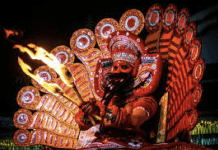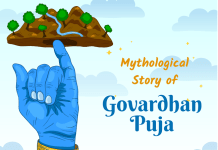
Govardhan Puja, also known as Annakut Puja or Annakoot Puja, holds a significant place in Hindu festivities, celebrated on the first lunar day of the bright fortnight of the month of Kartika, a day after Diwali. This festival reveres the divine incident where Lord Krishna, in his divine form, lifted the Govardhan Hill to shield the residents of Vrindavan from the wrath of Lord Indra. In this exploration, we immerse ourselves in the origins, rituals, and profound symbolism of Govardhan Puja.
Origins and Mythology of Govardhan Puja:
The roots of Govardhan Puja stretch into the revered Hindu scripture, the Bhagavad Gita. The legend unfolds as the people of Vrindavan, heeding Lord Krishna’s counsel, chose to worship the Govardhan Hill instead of Lord Indra, the rain god. Enraged by this deviation, Lord Indra released torrential rains upon the village. In response, Lord Krishna effortlessly lifted the Govardhan Hill with the little finger of his left hand, providing massive shelter for the villagers and their cattle.
Symbolism of the Govardhan Hill:
The Govardhan Hill embodies nature’s abundance and the divine protection it offers. Lord Krishna’s act of lifting the hill symbolizes the assurance that the divine force safeguards devotees from adversity. The emphasis on worshiping the hill directly connects to the Earth, acknowledging its sacred role in sustaining life.
Rituals and Celebrations:
Govardhan Puja unfolds with a tapestry of rituals and festivities. Devotees craft intricate cow dung or clay representations of the Govardhan Hill, adorning them with flowers and offerings. Circumambulation (parikrama) around this representation is a common practice. The puja involves offerings of food, grains, and sweets to Lord Krishna, symbolizing gratitude for the Earth’s abundant harvest.
Annakut: The Mound of Food:
A significant facet of Govardhan Puja is the creation of an elaborate array of food items known as “Annakut” or “mountain of food.” Devotees present a variety of vegetarian dishes, sweets, and fruits arranged in tiers to symbolize the Govardhan Hill. These offerings are then distributed as prasad, signifying the sharing of divine blessings.
Community Participation:
Govardhan Puja fosters a sense of community as devotees unite to celebrate and partake in the rituals. Temples organize processions, bhajans (devotional songs), and cultural programs. The festive spirit transcends religious boundaries, welcoming people from diverse backgrounds to join in the jubilations.
Environmental Significance:
In contemporary times, the festival assumes environmental relevance. The emphasis on worshiping the Govardhan Hill and the Earth underscores the imperative need for environmental conservation and sustainable practices. It encourages a harmonious relationship with nature, fostering awareness about the interconnectedness of all living beings.
Conclusion:
Govardhan Puja stands as a poignant reminder of Lord Krishna’s compassion and the divine protection bestowed upon devotees. Beyond its religious significance, the festival encapsulates values of gratitude, community bonding, and environmental consciousness. As the Annakut is offered with devotion and the divine lifting of the Govardhan Hill is commemorated, Govardhan Puja remains a celebration resonating with the timeless teachings of Lord Krishna, inspiring devotees to lead lives of virtue, gratitude, and environmental responsibility.



















































